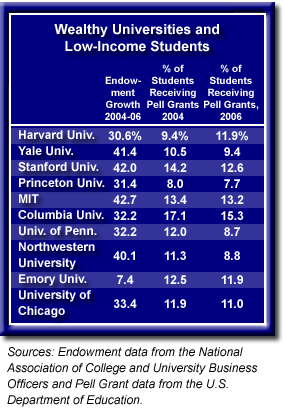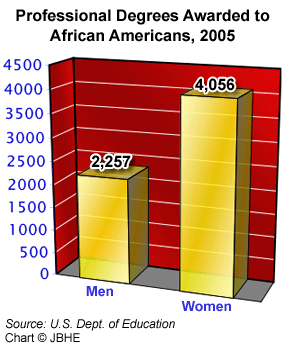The Nation’s Wealthiest Universities Are Doing a Poor Job in Enrolling More Low-Income Students
At the 10 universities in the United States with the largest endowments, the value of these funds have grown an average of more than 30 percent over the 2004 to 2006 period. But at nine of the 10 universities with the largest endowments, the percentage of low-income students has declined during the same period.
JBHE has obtained from the U.S. Department of Education new data on Pell Grant recipients. Although sometimes flawed or misread, U.S. Department of Education statistics on Pell Grants are generally accepted as a standard measure of the percentage and number of low-income students at a particular institution.
The Pell Grant data shows that in the two years from 2004 to 2006 Harvard University is the only one of the 10 universities with the largest endowments to show a gain in low-income students. At Harvard the percentage of all undergraduate students receiving federal Pell Grants increased from 9.4 percent in 2004 to 11.9 percent in 2006.
At the other nine universities with the largest endowments, the percentage of students receiving Pell Grants declined in the 2004 to 2006 period. In some cases the declines were modest. But at the University of Pennsylvania, the percentage of students receiving Pell Grants dropped from 12 percent in 2004 to 8.8 percent in 2006. At Columbia, the percentage of students receiving Pell Grants declined from 17.1 percent to 15.3 percent in just two years.
In reporting results for such a short, two-year time span, we must caution that data for any particular institution may be a statistical anomaly and may not be of great value as an indication of a long-term trend. Yet it is troublesome that over the long term of 23 years since 1983, eight of the 10 universities with the largest endowments have shown a decline in the percentage of low-income students. Only Emory University and Stanford University showed small increases in their percentage of low-income students in the 1983 to 2006 period.

Georgetown University Expands Pre-College Training Program for Black Youth
Georgetown University, the highly ranked Jesuit educational institution in the nation’s capital, has announced a major expansion of its Meyers Institute for College Preparation. The program is offered to public school students in the predominantly black Ward 7 of the District. The high school graduation rate in Ward 7 is only 38 percent.
 The program offers academic enrichment, mentoring, and college preparation programs for students from seventh grade through high school. In the past, a new group was enrolled in the institute every four years. Now with additional funding from the Meyers Foundation, a new group of seventh-grade students will enter the institute each year. The program offers academic enrichment, mentoring, and college preparation programs for students from seventh grade through high school. In the past, a new group was enrolled in the institute every four years. Now with additional funding from the Meyers Foundation, a new group of seventh-grade students will enter the institute each year.
Students who are accepted into the program spend Saturdays on the Georgetown campus participating in coursework and other activities. In addition, the students spend five weeks of their summer vacations involved in institute programs. In the summer of their junior year in high school, the students reside on the Georgetown campus for the five-week period.
Since 1989, 98 percent of the students who have enrolled in the institute have graduated from high school and have gone on to college.
Athletics Provides Thousands of Black Students With the Opportunity for Higher Education
 New data from the National Collegiate Athletic Association shows that in the 2005-06 academic year there were 82,230 students on athletic scholarship at the colleges and universities with the largest intercollegiate sports programs. Of these, 19,575, or nearly 24 percent, are black. New data from the National Collegiate Athletic Association shows that in the 2005-06 academic year there were 82,230 students on athletic scholarship at the colleges and universities with the largest intercollegiate sports programs. Of these, 19,575, or nearly 24 percent, are black.
Football is by far the sport with the most black scholarship athletes. In 2005-06 there were more than 8,900 black men on football scholarships. More than 4,300 black men and women were on athletic scholarships for basketball. Nearly 3,700 black men and women received athletic scholarships to compete in track and field.
More than 60 percent of black students on athletic scholarships eventually complete their degree program at some institution. Therefore, it is probable that nearly 12,000 of the 19,577 black students on athletic scholarship in 2005-06 will eventually earn their degrees. Many of these black students would not have had the opportunity to enroll in college if not for their prowess on the athletic field.
New Scholarship Program for Black Studies Majors at the University of Oklahoma Made Possible by Family of Former Governor
 Next fall the African-American studies department at the University of Oklahoma will offer three scholarships each year to students of any race who have excelled in black studies and are in financial need. The scholarships are made possible by a donation from the family of Raymond D. Gary, a former governor of Oklahoma. The family hopes that money will be raised to expand the program to 10 scholarships each year. Next fall the African-American studies department at the University of Oklahoma will offer three scholarships each year to students of any race who have excelled in black studies and are in financial need. The scholarships are made possible by a donation from the family of Raymond D. Gary, a former governor of Oklahoma. The family hopes that money will be raised to expand the program to 10 scholarships each year.
Gary, a Democrat, served from 1955 to 1959. He was the first governor of Oklahoma to be born in the state. Upon taking office, one of his first acts was to remove “whites only” and “colored only” signs from restrooms in the capital. He also ordered the state’s public schools to comply with the 1954 Brown v. Board of Education Supreme Court ruling.
Gary served one term and was barred by state law from seeking reelection. He died in 1993.

WINSTON-SALEM STATE UNIVERSITY

Executive Vice Chancellor for Strategic and Management Initiatives
General Summary:
The VCSMI is a senior position among the chancellor’s senior staff. The primary responsibility of this position is to ensure that the University's planning efforts and the chancellor’s priorities and strategic and management initiatives are communicated, well-coordinated, and implemented. By working closely with the chancellor, provost, vice chancellors, executive assistants, deans, and others, the VCSMI will work to achieve a more coordinated and integrated approach to an array of University priorities and goals. This position will also be responsible for oversight of the Office of Human Resources.
Essential Functions:
Ensure a more integrated approach to academic activities that entail cooperative efforts with multiple divisions or schools.
As a senior member of the chancellor's staff, advise the chancellor on a range of policy issues.
Independently manage, oversee and implement special projects and initiatives as directed by the chancellor. Conduct research, analyze issues and produce special reports and presentations as needed.
Provide ongoing analyses of institutional planning efforts and conduct or oversee special studies as needed to ensure that the chancellor’s initiatives and University priorities are being carried out at the highest level.
Represent the chancellor and serves as a liaison and internal spokesperson and primary point of contact for the chancellor with all areas of the University, including high-level University leadership and committees, external groups and professional organizations.
Education and Experience Required:
Master’s degree required. Prior officer-level administrative management experience within higher education required. Broad understanding of and experience with issues and policies in higher education required. Excellent oral and written communications skills required. Demonstrated research, analytical and computing skills required. Skills in resolving complex and divisive issues required.
Required:
Letter of Introduction
Curriculum Vitae
Hardcopy only, in sealed confidential envelope
Send to:
RaVonda Dalton-Rann
Assistant to the Chancellor
Winston-Salem State University
200 Blair Hall
Winston-Salem, NC 27110

Bob Jones on the Separation of Church and State
 Bob Jones University in Greenville, South Carolina, is a fundamentalist Christian college, which until only recently prohibited interracial dating. Traditionally, Bob Jones University has been a mandatory campaign stop for Republican presidential candidates seeking to solidify their conservative credentials in this important, early primary state. Bob Jones University in Greenville, South Carolina, is a fundamentalist Christian college, which until only recently prohibited interracial dating. Traditionally, Bob Jones University has been a mandatory campaign stop for Republican presidential candidates seeking to solidify their conservative credentials in this important, early primary state.
Bob Jones III, chair of the board of trustees at the university which bears his name, recently endorsed former Massachusetts governor Mitt Romney for president. The endorsement took many political observers by surprise. Most Christian fundamentalists scoff at the teachings of the Mormon Church, of which Romney is a member. In the past, Jones has called Mormonism “a cult.”
In defending his endorsement, Jones said, “I’m not voting for a preacher. I’m voting for a president. It boils down to who can best represent conservative American beliefs.”
Appointments
 • Andrew Hugine, president of South Carolina State University, was appointed by Secretary of Education Margaret Spellings to the Historically Black Colleges and Universities Capital Finance Board. • Andrew Hugine, president of South Carolina State University, was appointed by Secretary of Education Margaret Spellings to the Historically Black Colleges and Universities Capital Finance Board.
• Miji Bell was named director of public relations and communications at North Carolina Central University. She was a marketing communications manager at the Fuqua School of Business at Duke.
Bell is a graduate of Bennett College for Women and holds a master’s degree from the University of North Carolina Greensboro.
• Nathaniel Stinson Jr. was named acting director of the Office of Scientific Programs of the National Center on Minority Health and Health Disparities at the National Institutes of Health. He was a professor of family and community medicine at Meharry Medical College.
Dr. Stinson holds both a medical degree and a Ph.D. in environmental biology from the University of Colorado.
 • Paul Bibbins, dean of the Ohio University branch campus in St. Clairsville, announced that he will leave the university at the end of the year to take over the presidency of a non-profit educational foundation in Virginia. Bibbins has led the satellite campus since 2004. He previously was a professor of biology, dean, and interim president of Kentucky State University. • Paul Bibbins, dean of the Ohio University branch campus in St. Clairsville, announced that he will leave the university at the end of the year to take over the presidency of a non-profit educational foundation in Virginia. Bibbins has led the satellite campus since 2004. He previously was a professor of biology, dean, and interim president of Kentucky State University.
Awards
• James Frank, former president of Lincoln University in Missouri, will receive the Gerald R. Ford Award for leadership in higher education and intercollegiate athletics from the National Collegiate Athletic Association. Frank served as president of the NCAA from 1981-82, the first African American to do so.
Dr. Frank is a graduate of Lincoln University and holds a master’s and a doctorate from Springfield College.
 • John Rogers Jr., CEO of the investment firm Ariel Capital Management, was chosen to receive the Woodrow Wilson Award from Princeton University. The award is given to a graduate of the university who has made an outstanding contribution to the nation’s service. • John Rogers Jr., CEO of the investment firm Ariel Capital Management, was chosen to receive the Woodrow Wilson Award from Princeton University. The award is given to a graduate of the university who has made an outstanding contribution to the nation’s service.
 • Carrie Houser James, an assistant professor of nursing at South Carolina State University in Orangeburg, was the recipient of the Distinguished Nursing Award from the South Carolina Nursing Association. She was the first African American to graduate from the nursing program at the University of South Carolina. • Carrie Houser James, an assistant professor of nursing at South Carolina State University in Orangeburg, was the recipient of the Distinguished Nursing Award from the South Carolina Nursing Association. She was the first African American to graduate from the nursing program at the University of South Carolina.
|

The Gender Gap in Professional Degree Awards to Blacks
The year 1989 was the first year that black women earned more professional degree awards than black men. Today the gender gap in professional degree awards to African Americans is large but not as wide as in bachelor’s and master’s degree attainments. In 2005 black women earned 64 percent of all professional degrees awarded to African Americans, up from 62 percent the previous year.

  |
“We have worked aggressively over the past several years to expand financial aid.”
— William Fitzsimmons, dean of admissions and financial aid at Harvard College, in an announcement that he would be visiting 19 cities across the country with his counterparts at Princeton University and the University of Virginia in an effort to recruit minority and low-income students and to educate them about the generous financial aid opportunities at the three universities (See related story above.)
|
New Race-Based Scholarship Program Established at Drury University
 Drury University, a private educational institution in Springfield, Missouri, has nearly 4,500 undergraduate students. But only 3 percent of the student body is black. Drury University, a private educational institution in Springfield, Missouri, has nearly 4,500 undergraduate students. But only 3 percent of the student body is black.
In an effort to boost racial diversity on campus, Drury University, in conjunction with the St. Louis-based financial services firm Edward Jones, has launched the Edward Jones Minority Scholarship Program. The program will be open to blacks and other underrepresented minority students. The $10,000 scholarships will be available to minority students who have been accepted to the university. An additional $7,500 in merit-based awards are available to Edward Jones scholars. The scholarships are renewable for a student’s four years at Drury. Ten scholars will be named each year. Preferences will be given to minority students from southwest Missouri and northwest Arkansas.
Duke University Aims to Enhance Racial Interaction on Campus Through Dual Sponsorship of Social Events
 Self-segregation is a major problem on the campuses of many predominantly white colleges and universities. On many campuses blacks, whites, Hispanics, and other racial and ethnic groups tend to congregate and socialize with members of their own group. Self-segregation is a major problem on the campuses of many predominantly white colleges and universities. On many campuses blacks, whites, Hispanics, and other racial and ethnic groups tend to congregate and socialize with members of their own group.
At Duke University, the Center for Race Relations has come up with a novel plan to encourage more interaction between racial and ethnic groups. The center’s social arm — Students to Unite Duke (STUD) — provides funds to several different groups on campus to organize a single event such as a dance or other social gathering. Thus a single party or other gathering might be co-sponsored by the black student association, a women’s rights group, and a predominantly white fraternity. The goal is to bring different groups of people together to socialize. Events held so far seem to have attracted a diverse group of students and have been met with generally favorable reviews from those who have attended.
  |
8.2% Percentage of white K-12 students in public schools in 2003 who had repeated a grade at some point in their educational careers.
17.1% Percentage of black K-12 students in public schools in 2003 who had repeated a grade at some point in their educational careers.
source: U.S. Department of Education
|
North Carolina State University Is a Mecca for Black Mathematicians
According to new data compiled by Donna J. Nelson at the University of Oklahoma, blacks make up only 1.5 percent of the total faculty in the mathematics departments at the 100 universities that conduct the most research in the discipline. All told there are 64 black faculty in the mathematics departments of these 100 universities.
 There are nine black mathematicians at Jackson State University in Mississippi, four at Morgan State University in Maryland, and six at Norfolk State University in Virginia. These three historically black universities are all among the universities with the 100 largest research budgets in the field. This means there are only 43 black mathematicians at the remaining 97 predominantly white universities. There are nine black mathematicians at Jackson State University in Mississippi, four at Morgan State University in Maryland, and six at Norfolk State University in Virginia. These three historically black universities are all among the universities with the 100 largest research budgets in the field. This means there are only 43 black mathematicians at the remaining 97 predominantly white universities.
Remarkably, according to Dr. Nelson’s research, there are six black full professors teaching mathematics at North Carolina State University in Raleigh. They make up more than 10 percent of the total mathematics faculty at the university.
There are three black faculty members in the mathematics departments at Penn State and the University of Colorado. None of the other 94 predominantly white universities has more than two black mathematicians on its faculty.
Two thirds of the 100 universities with the largest budgets for mathematics research have no black faculty mathematics faculty whatsoever.
Noted Saxophonist Offers a Unique Opportunity for a Student Tuba Player
 Saxophonist Andre Delano is returning to his alma mater, Jackson State University, the historically black educational institution in Mississippi, to record a track for his new album. The album, entitled My So Fine, is scheduled for release next June. Saxophonist Andre Delano is returning to his alma mater, Jackson State University, the historically black educational institution in Mississippi, to record a track for his new album. The album, entitled My So Fine, is scheduled for release next June.
The song will be a tribute to Delano’s undergraduate days at Jackson State. Delano will hold auditions on campus to give a student tuba player the opportunity to accompany him on the new track.
Historically Black Law School Deemed to Be the “Best Value”
 The law school at North Carolina Central University, the historically black educational institution in Durham, was recently designated by preLaw magazine as the law school in the United States with the “best value.” North Carolina Central edged out the law school at the University of Alabama for the top spot. The law school at North Carolina Central University, the historically black educational institution in Durham, was recently designated by preLaw magazine as the law school in the United States with the “best value.” North Carolina Central edged out the law school at the University of Alabama for the top spot.
The magazine rated law schools on tuition, bar passage rate, and employment prospects of graduates. Upon hearing the results of the survey, Dean Raymond Pierce stated, “We have turned this law school into a world-class institution. Our costs remain steady, affordable, and when our students graduate, they are not saddled with unmanageable debt.”
JBHE’s latest enrollment data shows that there are 242 black students at the law school, making up slightly less than one half of the entire student body. The law school’s bar passage rate of 86 percent is significantly higher than the 71 percent average for all law schools in North Carolina.
Columbia Students Call Off Hunger Strike Over Issues Related to Race
Two weeks ago, six students at Columbia University began a hunger strike to protest the university expansion into the surrounding Harlem neighborhood. The strikers also demanded changes in the core curriculum, expansion of the Office of Multicultural Affairs, and the hiring of additional faculty members at the Center for the Study of Ethnicity and Race and the Institute for Research in African American Studies.
After four days, one of the strikers fainted and was taken to the hospital. A week after the strike began, the university administration agreed to make the changes in the core curriculum the students sought, to hire three additional faculty members, to expand the Office of Multicultural Affairs, and not to discipline any of the hunger strikers. However, the university did not budge on its plan to expand into west Harlem and the hunger strike continued.
This past Thursday night, the students agreed to call off the hunger strike. On Friday, a joint statement was issued stating that both sides would work together to resolve their remaining differences and achieve their goals of building a better Columbia.

Readers who want more information on the hunger strike, click here.
In Memoriam
John L. Warfield (1936-2007)
 John L. Warfield, who served on the faculty at the University of Texas at Austin for 26 years and headed the university’s Center for African and African American Studies for more than a decade, died recently at his home in Kalamazoo, Michigan, after a long battle with Parkinson’s disease. He was 71 years old. John L. Warfield, who served on the faculty at the University of Texas at Austin for 26 years and headed the university’s Center for African and African American Studies for more than a decade, died recently at his home in Kalamazoo, Michigan, after a long battle with Parkinson’s disease. He was 71 years old.
Professor Warfield was a native of Noblesville, Indiana, but his family moved to Kalamazoo when he was an infant. His father was a Baptist minister. Warfield earned a bachelor’s degree in psychology at Kalamazoo College. He also held a master’s degree in clinical psychology from the University of Denver and a Ph.D. in counseling psychology from the University of Oregon.
In 1969 Dr. Warfield was appointed to the faculty at Macalester College in St. Paul, Minnesota. Four years later, he joined the psychology faculty at the University of Texas and remained there until his retirement in 1999.
The University of Texas has announced that the Center for African and African-American Studies will be renamed in his honor.
Julia Agnes Washington Bond (1908-2007)
Julia Bond, former university librarian and the mother of NAACP chair Julian Bond, died in her sleep in her Atlanta apartment earlier this month. She was 99 years old.
A graduate of Fisk University, Bond was married to Horace Mann Bond, who served as president of both Lincoln University in Pennsylvania and Fort Valley State University in Georgia. He also served as dean of the Atlanta University School of Education. When the family moved to Atlanta, Julia Bond became a reference librarian at what is now Clark Atlanta University. She served part-time on the library staff until her retirement at age 92.
Percy O. Vera (1935-2007)
Percy O. Vera, the first black professor at Sinclair Community College in Dayton, Ohio, died late last month at his home in Dayton. He was 71 years old.
A native of Belize, Vera joined the faculty at Sinclair Community College in 1967. There he founded the culinary arts and hospitality management program. In 1975 Professor Vera was named chair of the department of economics and management. He held that position until his retirement in 1997.
Grants
• North Carolina A&T State University, the historically black educational institution in Greensboro, received a three-year, $200,000 grant from the U.S. Department of Energy for research on developing a coating for film membranes used in hydrogen separation technology.
• Cornell University in Ithaca, New York, received a three-year, $630,000 grant from the Andrew W. Mellon Foundation to continue the Future of Minority Studies Summer Institute. The program brings college juniors and seniors, graduate students, postdocs, and untenured faculty to Cornell to participate in interdisciplinary research projects.
• Southern University, the historically black educational institution in Baton Rouge, Louisiana, received a three-year, $200,000 grant from the U.S. Department of Energy for the development of an air plasma spray for making new thermal barrier coatings for advanced gas turbines.
|
 .
.